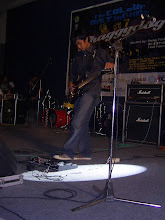Although practicing the previous chromatic scale will certainly provide you with great benefits (like limbering up your fingers), it is admittedly not a whole lot of fun. Most people love to play "chords" on the guitar. Playing a chord involves using your pick to strike at least two notes (often more) on the guitar simultaneously. The following are three of the most common, and easy to play chords on the guitar.
Playing a G major chord
This diagram illustrates the first chord we are going to play, a G major chord (often simply called a "G chord"). Take your second finger, and put it on the third fret of the sixth string. Next, take your first finger, and put it on the second fret of the fifth string. Lastly, put your third finger on the third fret of the first string. Make sure all of your fingers are curled, and are not touching any strings they're not supposed to. Now, using your pick, strike all six strings in one fluid motion. Notes should ring all together, not one at a time (this could take some practice). Voila! Your first chord.Now, check to see how you did. While still holding down the chord with your fretting hand, play each string (starting with the sixth) one at a time, listening to be sure each note rings out clearly. If not, study your hand to determine why it doesn't. Are you pressing hard enough? Is one of your other fingers touching that string, which is preventing it from sounding properly?
Playing a G major chord
This diagram illustrates the first chord we are going to play, a G major chord (often simply called a "G chord"). Take your second finger, and put it on the third fret of the sixth string. Next, take your first finger, and put it on the second fret of the fifth string. Lastly, put your third finger on the third fret of the first string. Make sure all of your fingers are curled, and are not touching any strings they're not supposed to. Now, using your pick, strike all six strings in one fluid motion. Notes should ring all together, not one at a time (this could take some practice). Voila! Your first chord.Now, check to see how you did. While still holding down the chord with your fretting hand, play each string (starting with the sixth) one at a time, listening to be sure each note rings out clearly. If not, study your hand to determine why it doesn't. Are you pressing hard enough? Is one of your other fingers touching that string, which is preventing it from sounding properly?

Playing a C major chord
The second chord we'll learn, the C major chord (often called a "C chord"), is no more difficult than the first G major chord.Place your third finger on the third fret of the fifth string. Now, put your second finger on the second fret of the fourth string. Finally, put your first finger on the first fret of the second string.Here's where you have to be slightly careful. When playing a C major chord, you do NOT want to strum the sixth string. Watch your pick to make sure you only strum the bottom five strings when you are first learning the C major chord. Test this chord as you did with the G major chord, to make sure all notes are ringing clearly.

Playing a D major chord
Some beginners have slightly more difficulty playing a D major chord (often called a "D chord"), since your fingers have to cram into a fairly small area. Shouldn't be too much of a problem, however, if you can comfortably play the other two chords.Place your first finger on the second fret of the third string. Then, put your third finger on the third fret of the second string. Lastly, place your second finger on the second fret of the first string. Strum only the bottom 4 strings when playing a D major chord.
Spend some time familiarizing yourself with these three chords... you will use them for the rest of your guitar-playing career. Make sure you can play each of the chords without looking at the diagrams. Know what the name of each chord is, where each finger goes, and which strings you strum or do not strum.


No comments:
Post a Comment